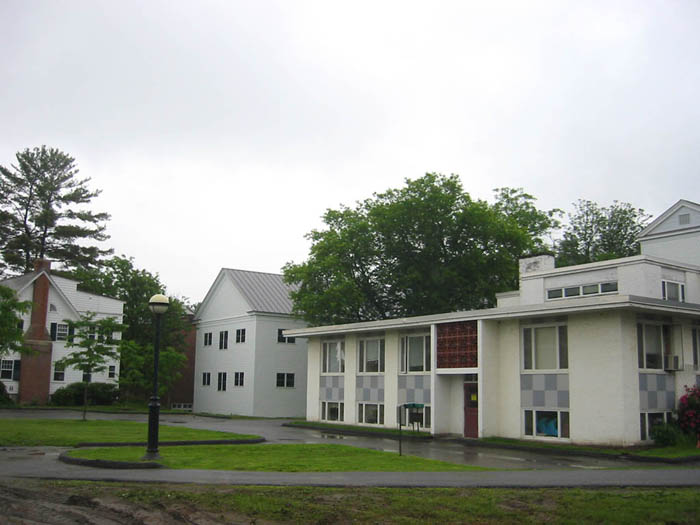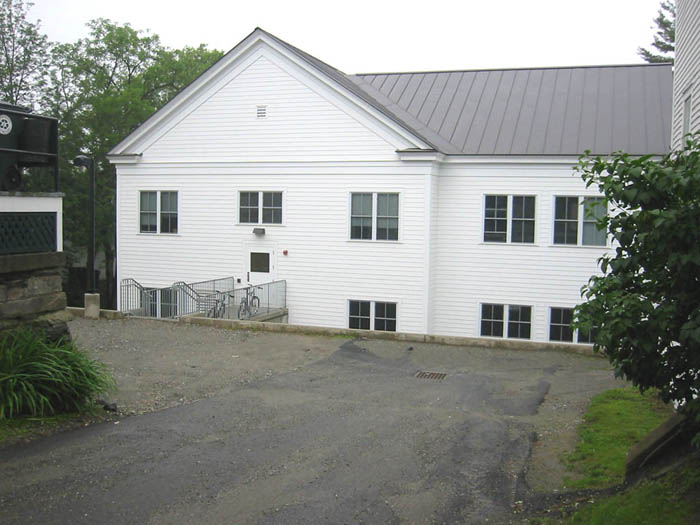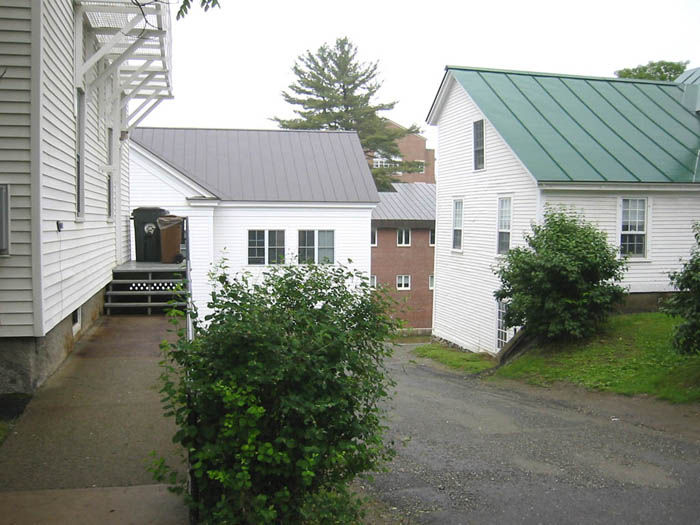-
An article in The Dartmouth notes the completion of work on Reed and Baker and the start of work on Dartmouth Hall.
-
The HGA [architects] page for the CECS building has an image showing main entrance with the name KEMENY HARDENBERG above the door.
-
The Goody Clancy page on the Irving Institute is up.
-
What might have been: The central and right-hand groups of images on Samer Afifi’s site show (1) a more traditionally-massed CECS on the site where it is now being built and (2) a very unfortunately sited Irving Institute way back on the River Cluster site — not only distant from any important campus axis but also blocking any further Tuck School expansion.
-
This has been noted here before, but it is always fun to see: A Kliment/Halsband-designed addition to the Shower Towers to house Sudikoff. It looks perfectly pleasant, but it must have been overtaken by VSBA planning for Berry Row.
-
Kellogg Auditorium, perhaps the only building at Dartmouth named for a room, has been renamed Kellogg Hall and renovated as a classroom building. It opened last fall (Susan Green, “Newly Renovated and Renamed Kellogg Hall Opens” (29 September 2020)).
-
Dartmouth News has a piece on the importance of the DHMC parking lot as a social space in pandemic times.
-
Many outlets, including the Concord Monitor, have written about the huge college-affiliated apartment complex that will be built on Route 120 at Mt. Support Road.
-
The Davison Block, a prominent and historic commercial building at the top of Main Street in downtown Hanover, has been sold by the Davison family, reports the Valley News.
-
The Valley News also had an article on a sort of Christkindlmarkt that was set up in Hanover over the holidays. Fantastic. So many nice touches could be added to downtown, especially on South Main Street above Lebanon Street, whether by raising the street level (happening?), adding bollards, or limiting traffic and parking. An inviting town square could be delineated in front of the Municipal Building.
-
The Valley News reports on the college’s pullback from the idea of a new biomass heating plant. This is probably good news for the preservation of the old smokestack.
-
There are some great photos in the annual roundup of shots by Dartmouth photographers. The aerial of Baker Lawn does look like a De Stijl painting, as noted. It might look even more like a work in batik, an impression created by the imperfections in the edges of the paths and the snow-covered roofs.
Category Archives: Sudikoff
The master plan: initial impressions
See the latest version of Planning for Possibilities on the Presentations and Outcomes page. So far, the October 2020 draft plan and a slide deck have been posted.
The new master plan is very impressive.
The scope of the plan is impressive. It is the first master plan for the college to at least account for all college properties (the map on page 5 is zoomed out so far that it shows part of Canada) and the first plan to frame the campus in a regional context. Especially where transit is concerned, the Organic Farm and DHMC really do need to appear on the same map.
The document is more readable and less technical than its predecessors. Its creators made the interesting decision to use oblique aerial views exclusively — meaning that none of the proposals for development appear as flat “plans.”
The potential projects on campus look excellent. Placing a building on the lawn of Shabazz Hall makes so much sense. The natural site for a new physical sciences building beyond Burke of course requires yet another demolition of Dragon. The proposals for Bartlett and Wheeler additions are fantastic, with the latter being particularly bold. The natural row behind Mass Row could incorporate an abutment of, or at least an entry plaza for, the Cemetery Bridge at its south end. The Bema pavilion makes sense (maybe the place will see more use if it has a proper covered stage?), though erecting a frame building would be unusual in that space.
One might wish the planners had considered building on the vacant lots in front of Sanborn and south of Blunt as well. And why not show a building site on Berry Row between Kemeny and Moore? It has always been planned that way, even going back to VSBA days after the purchase of the hospital property. Oh well. (The plan also does not clearly note the anticipated Ledyard Canoe Club replacement, but that is not important.)
Here’s hoping that the college preserves the old frame buildings that are now standing on the various development sites. There are two buildings on the site behind Mass Row, two on the Choate Road corner, two in front of Thompson, and two on College Street next to Sudikoff. There is also a certain amount of appeal to the idea of saving Sudikoff itself, the village-like assemblage of brick house-forms, and of saving Raven, but neither building is of a scale to stand up to Moore Hall next door. Clearing the Sudikoff corner is the breaking of eggs to make an omelet in this plan.
The big question: Hilton Field (the western portion of the golf course)
The plan proposes that the oldest portion of the shuttered golf course be turned into an arboretum. This is a clever choice, especially given the neighborhood and its sensitivities. An arboretum really is typologically and functionally similar to a golf course or, for that matter, a city park or a cemetery. In the end, this minor change in use might amount to nothing more than ceding the land to nature as at the adjacent (and intermingled!) Pine Park. And yet an arboretum will not take Hilton Field off the table for some distant future development if it is needed. Still, the college would probably be remiss not to put a half-dozen houses for sale to faculty along Hilton Field Road at the same time it lays out the arboretum. What an opportunity!
East and North of the Green
The Thel sculpture is not mentioned, but it might be endangered:
Fairchild Field
A new shared surface for cars, pedestrians, and bikes, in lieu of a vehicular access road, creates better pedestrian connections between the Physical Sciences Complex and the Historic Core.
Anything that replaces the access road would be an improvement.
The plan devotes a great deal of attention to Fairchild Tower. It proposes a new interior stair and a bridge (to Wilder, presumably). Fairchild has always seemed a chilly, hollow signpost, but the illustrations in the plan remind us of how stylish it is.
Moving south across Wheelock Street, the big Vox Lane redevelopment image shows McKenzie and the Store House as not only preserved but expanded vertically into a “wellness” building — fantastic. That will be one of the most architecturally interesting buildings on campus. (This proposal was not included in an August presentation image and thus seems to be a recent inspiration.)
South of the Store House is shown a parking garage on the FO&M corner. Fine, but one hopes that it will have retail uses on the ground level. It could make for a neat visitor entry to campus: you drive to town, park in the garage, follow the signs to the back door of Wilson Hall — the new admissions office, in this plan — and when you embark on your campus tour and pass through Wilson’s great arch you see the Green laid out before you.
It is good to see the athletics promenade alongside Leverone (page 52). And Piazza Nervi is on the map, described this way:
Park St Gateway
A gracious gateway to athletics and the campus visually connects the Leverone Fieldhouse and Thompson Arena, both historic modernist structures designed by Pier Luigi Nervi.
That “gateway” project would move the two houses currently blocking the view of Thompson Arena and, interestingly, would add a roadway in front of Thompson. Clever: lining a lawn with streets sets it off as a public space, a public green.
North Campus
The architects’ image of a Maynard Street Green on page 45 looks like a Currier and Ives print.
The plan mentions the possibility of moving all existing uses out of the Rope Ferry Road buildings and turning the buildings into graduate dorms. Interesting! But wait, do they mean vacating Dick’s House too? They do, apparently — which would be too bad. Would there be any infirmary on campus, or have student health services become a collection of vending machines? Presumably the infirmary would go to the “wellness” building at McKenzie. If that is what it takes to save McKenzie, then so be it.
And beyond: Land banks on Lyme Road
The new buildings north of the Class of 1978 Life Sciences Center are a great start, and there could be many more here. Dewey Lot has so much space, as stated in the report, and so much potential. The depression here creates a fantastic opportunity for an extensive below-grade parking deck. As stated on this site in the past, however, the functions placed here should not be college-related. This is no more a part of the campus than is the CVS (Grand Union) building, and college ownership of this site does not change that fact.
Moving up along Lyme Road outside of town: The two alternative land bank locations labeled “Site 1” will inevitably be suburban and oriented to Lyme Road, notwithstanding the plan’s idealism about self-driving cars. They really will have parking lots, because they will become office parks and convenience stores. As far as the choice between near and far, the farther site, next to the fire station, seems preferable. There is less chance that it will contain anything that undergraduates would need to visit.
More on the two locations of Geisel, the Grand Limited-Access Road, and the rest of the plan in a future post.
West End work beginning
The Thayer School expansion involves a lot of changes to an entire district of the campus. Campus Services has information on the overall project.
The page describes the new Thayer School building:
The proposed building, to be located south of the Maclean Engineering Sciences Center, will be constructed over a new three-level parking garage. The garage will replace Cummings lot, and will significantly increase the number of parking spaces in this area. This project will also change the flow of traffic along West Wheelock Street and throughout the West End. Thayer Drive will close, and a new access road will be constructed specifically to provide access to the parking garage, and Thayer loading docks and the Channing Cox parking lot. Old Tuck Drive will be reconstructed and reopened to support one-way traffic heading from west to east. Improvements to the intersection of West Wheelock, West Street, and the new access road will also be made to improve access and safety of pedestrians, cyclists and drivers.
Dartmouth News has a story on the proposal for a new set of stoplights on West Wheelock Street at Thayer Drive (see also the Valley News).
We learn from the college news story that the Thayer School building “will be connected at ground level to the MacLean Engineering Sciences Center and Cummings Hall.” Presumably “at ground level” means aboveground as opposed to belowground, where the garage is. Because renderings show only a second-level bridge connecting the new building to MacLean; pedestrians will go under the bridge to follow the “Green to Blue” route. See this rendering reproduced from the latest Dartmouth Life print publication (showing the existing brick wall of MacLean in white on the right):
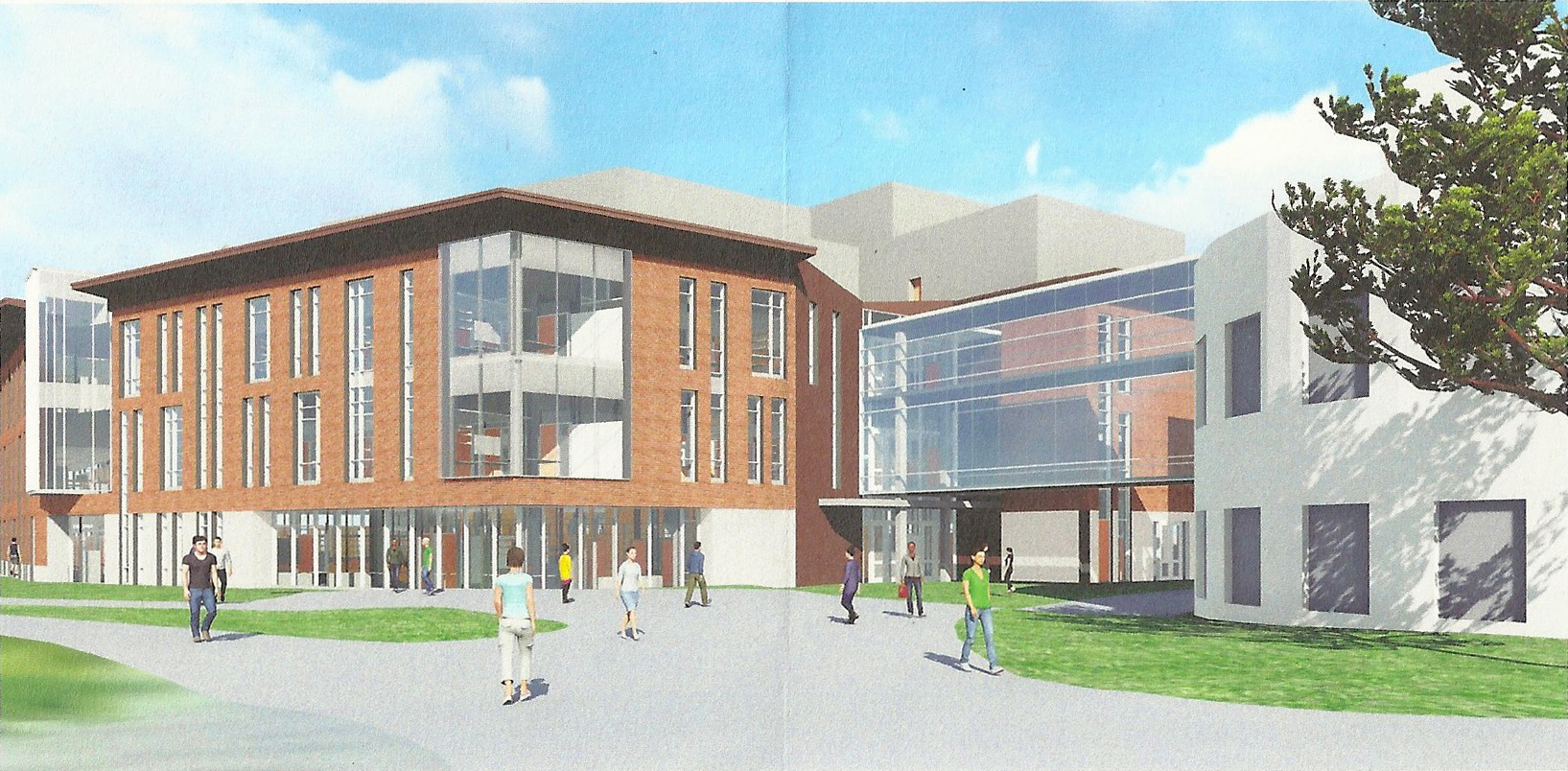
Incidentally, the college’s project manager for the Beyer Blinder Belle West End Master Plan was planner Douwe Wieberdink; he’s now with BBB. And the landscape architects for the West End work are Michael Van Valkenburgh Associates: perhaps one can feel a bit better about the fate of historic Tuck Drive following its partial demolition.
Details on the new road to the Thayer & CS building
The BBB West End Master Plan (super image from BBB site; see also the Campus Services project page, written by BBB) turns out to be more than a schematic design. The meandering suburban business-park road is going to be built:
Another change will be the removal of Engineering Drive, which runs from West Wheelock Street to the Cummings lot. A new roadway, called West Access Road, will be constructed to provide access to the parking garage and Thayer loading facility as well as limited access to the West End Circle. A now-closed portion of Old Tuck Drive, which originates just above the swim docks and the Ledyard parking lot, will be reopened and will connect the roadway to Tuck Mall, pending town approval.11. Susan J. Boutwell, “Integrating Engineering, Computer Science, Entrepreneurship,” Dartmouth News (28 March 2018).
The project page for the Thayer/CS building provides more detail: “Engineering Drive will close, and a new access road will be constructed specifically to provide access to the parking garage and Thayer loading docks. Old Tuck Drive will be restored and reopened to support one-way traffic heading from west to east.”
Maybe the site conditions (steep slopes, existing buildings) require the endearingly-named West Access Road to look the way it does. After all, Tuck Drive22. Please, let’s stop calling it Old Tuck Drive. The word “Old” seems to have been added to the name of Tuck Drive to distinguish the short branch of the road that was eliminated by Fahey-McLane. That was a dozen years ago. There is no need to keep using the word. is a curving, naturalistic auto road. Yet one hopes that the new road will respect urban principles by reinforcing campus spaces.
One also hopes that the West Access Road will be reconnected to Tuck Mall once construction of the building is completed: that would seem to be the reason for the two-level pedestrian bridge that will join the building to the McLean ESC.
From the Dartmouth News article: “Construction is expected to start early next year on a three-level underground parking and loading facility, which will sit below the four-floor education portion of the building.” In the map that accompanies the article, the entrance to that subterranean lair underground garage appears just off the southwest corner of the new building. Last fall, the project page included a view of the building’s south facade from which is taken this detail showing the intriguing, grottolike entrance:
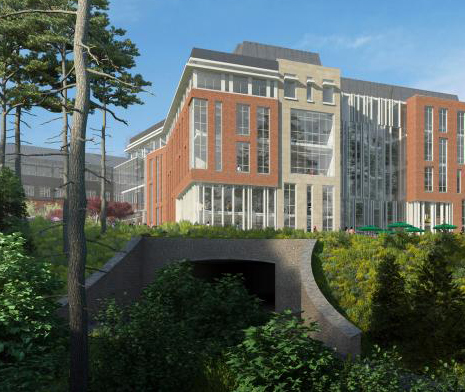
| ↑1 | 1. Susan J. Boutwell, “Integrating Engineering, Computer Science, Entrepreneurship,” Dartmouth News (28 March 2018). |
|---|---|
| ↑2 | 2. Please, let’s stop calling it Old Tuck Drive. The word “Old” seems to have been added to the name of Tuck Drive to distinguish the short branch of the road that was eliminated by Fahey-McLane. That was a dozen years ago. There is no need to keep using the word. |
Varied topics in history and architecture
The Neukom Institute was rumored last year to be considering a request for an addition to Sudikoff.
Ledyard Canoe Club plans to rebuild Titcomb Cabin, which burned last spring. The logs will be put in the river at the Organic Farm and rafted down to Gilman Island. This will be the closest thing to a log drive seen on this stretch of the Connecticut in many years.
David Hooke (Reaching That Peak, 1987) gave a “smoke talk” in Commons on the Outing Club’s history. The Dartmouth reports that “smoke talk” refers to the club’s journal Woodsmoke, but it might also refer to the informal lectures of that name that took place in College Hall at the turn of the century.
The Wall Street Journal has an article on Venturi, Scott Brown and Associates that, although not mentioning it, helps explain their Berry Library project.
Check out the buildings in Dartmouth’s Flickr photostream.
The Dartmouth is doing a weekly articles on Dartmouth out-of-town, starting with the riding center at Morton Farm.
Dartmouth is offering for rent the second level of the 1910s library stacks addition to Eleazar Wheelock’s house. This could make a good society hall:
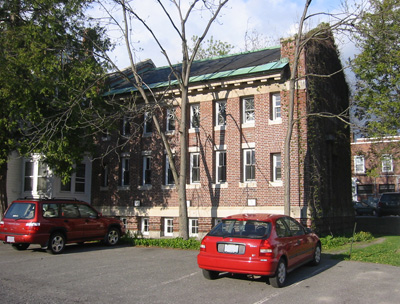
Rear ell, 4 West Wheelock Street, Hanover
—–
[Update 11.17.2012: Broken link to VSBA page fixed; broken link to rental page removed.]
Sudikoff addition
Tuck Mall dorm model
Atkin Olshin Lawson-Bell, designers of the Collis Center addition and McCulloch Hall, have posted photo of a model of the future Tuck Mall Dormitory. The building will stand atop the short street that connects Webster Avenue to Tuck Drive and will include a faculty apartment.
The Sudikoff addition, designed by Fleck & Lewis Architects of Hanover and built by Engelberth Construction, is in progress and at this point looks rather more like a New England clapboard than the building to which it is attached.
Construction of the addition to Sudikoff should be completed by the fall, The Dartmouth reports.
Sudikoff addition
The addition to Sudikoff has gotten underway.
Architect for new arts building
Perhaps the most architecturally-interesting news is the announcement that the school is selecting an architect for a new arts building, presumably in the vicinity of the Hood and Clement.
The College has given the go-ahead to begin building the Kemeny Center for the math department as well as an adjoining building for a group of academic institutes, according to President Wright. Construction on the NoMa dormitories and dining hall will begin by the fall of 2004. The addition to Sudikoff also will get underway.
South Block project
The South Block redevelopment project is accellerating; the school’s Real Estate site plans more information.
Plenty of projects are in the works, all summarized in the most recent master plan (June 2002): highlights include the design work pending for a modular addition to Sudikoff and the evaluation of sites behind Fayerweather Row for a Commons House.
Planning ideas
Reid Coggins ’04, student representative to a campus planning committee, notes several new ideas in discussion:
- Tentative plans to demolish Hinman (the River Cluster dormitory) and build a new Tuck School building in its place
- Longer-term plans to alter or even demolish the Choates
- Plans to add to Sudikoff to provide more space for Computer Science
- Plans by the Church of Christ for renovations that may improve the Berry-Maynard vista.
